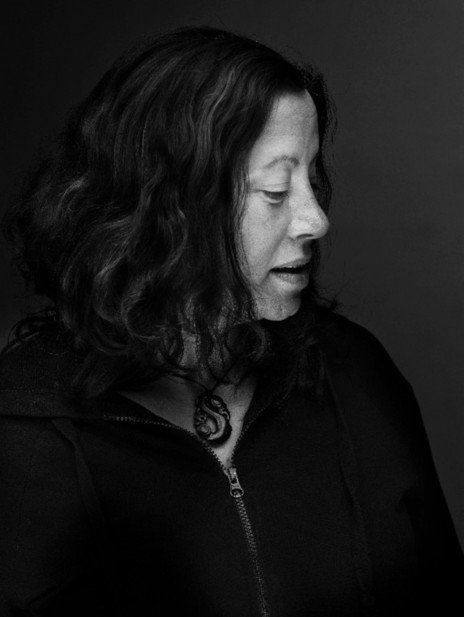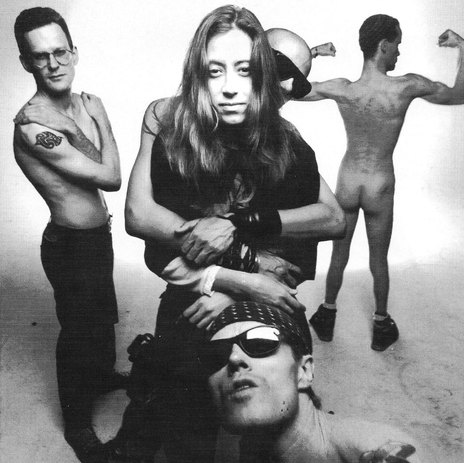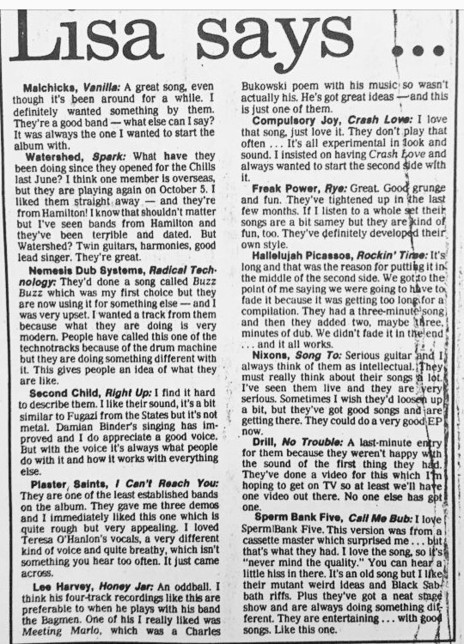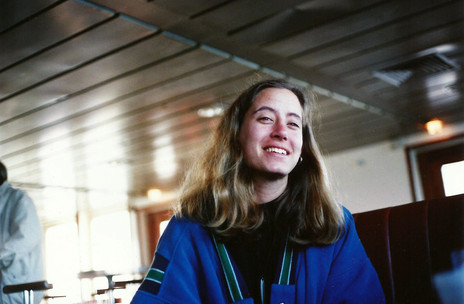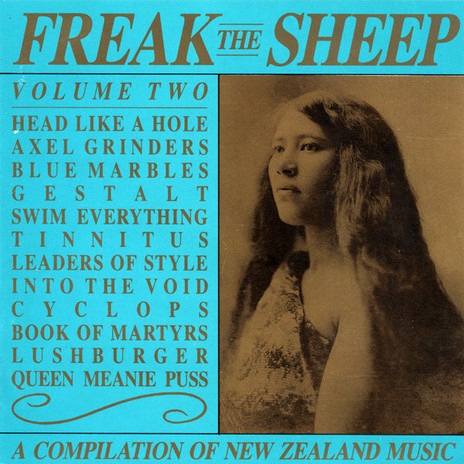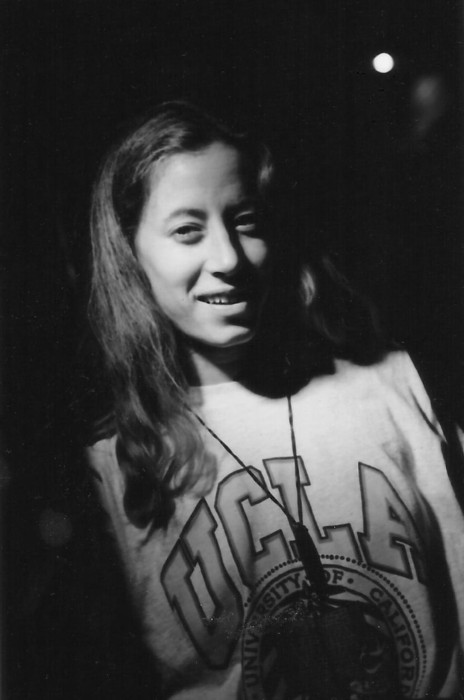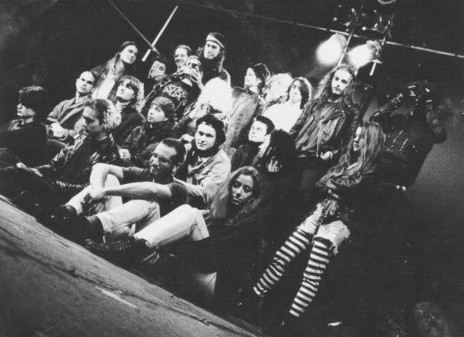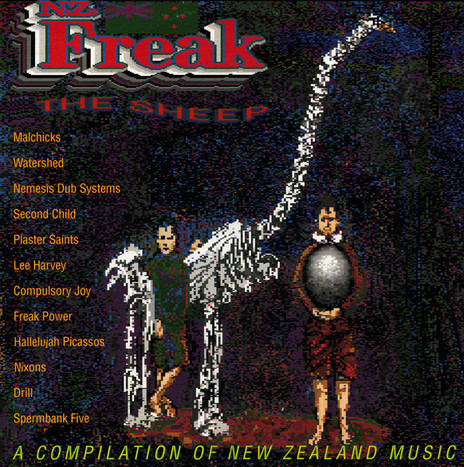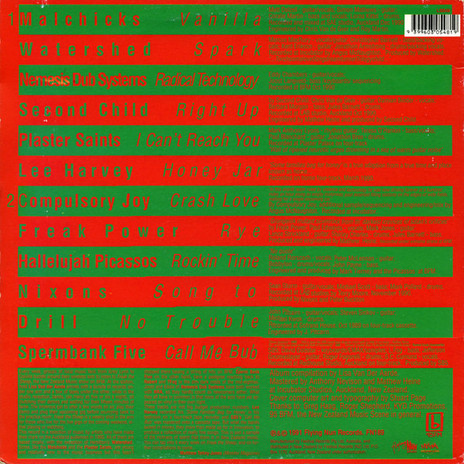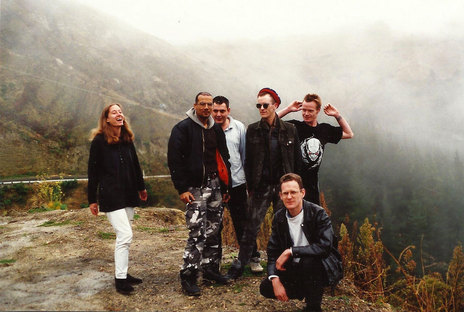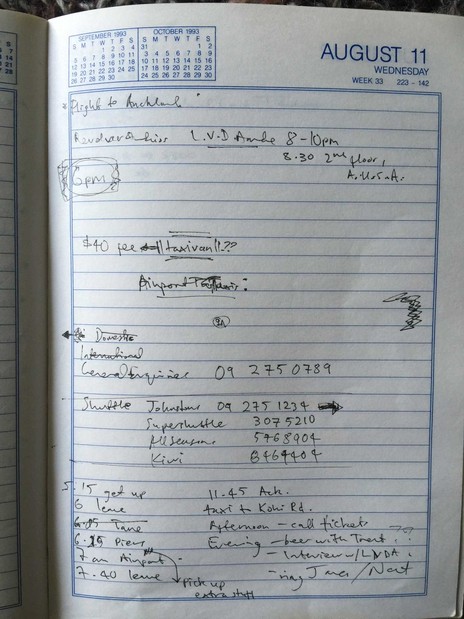Born in Los Angeles to an American dad and a New Zealand Māori mum, the Van Der Aarde family came to New Zealand for a visit when Lisa was eight, and they stayed. Of Ngāpuhi descent, Lisa and her family lived for a while on the family farm in Hukerenui before moving to Symonds Street in the heart of Auckland city, with Karangahape Road as their playground: an eye-opener for any kid.
Schooled by day at Epsom Girls Grammar School (EGGS) and by night by live music from around the age of 15, and schooled at home in the music of Johnny Cash, Roy Orbison, Elvis Presley, Jimi Hendrix and John Rowles, music became an unshakeable force for Van Der Aarde from early on. “Our household always had the radio blasting. Whenever I heard a song I liked I would write it down (and still do that).”
Embarking on an English degree at University of Auckland in 1982, Van Der Aarde made friends with Francis Hooper (co-founder of the World fashion label), who introduced her to bFM. “Me and my Buddy Elisabeth Callaghan would go up to the station and hang out. It was known as Campus Radio before it was known as 95bFM and when it was still broadcasting part time. At that time there were maybe five Andrews: Boak, Dickens, Hawthorne, Topping, Bishop (the late Andrew Black came later). Also part of the bFM crew were Jonathan Roper, Jonathan Ganley, Chris Forster, Chris Esther (who hosted the New Zealand Music Show of the day), James Schoning and Phil Bishop who did the early breakfast shows.” [Van Der Aarde apologises if she’s missed anyone from the 82/83 era!]
“Francis Hooper would read the news trying not to crack up laughing on the more serious stories – at this time the station obviously wasn’t hugely professional! We were all there for the love of music – I tried to read the news a few times but found I too could not read it seriously without laughing, so that wasn’t for me. Andrew Topping [Programme Director] suggested I start doing shows, and at that time there was only one other woman broadcasting – Florence Brady (Hi Florence!) – and so it began.”
She started doing the New Zealand Music Show in 1987 and decided to change the name to Freak the Sheep, after an on-air jingle with those words.
Van Der Aarde’s first show was the Saturday morning 7am to 10am slot – “as all newbies did”. She also recalls, “In those days too there was no production studio at all, so a carload of us would go out to Radio Pacific to make the ads – so much fun!” She then moved into the Drivetime 4-7pm slot, which included the infamous accommodation guide. “I remember Sonic Youth were up at the station for an interview and Thurston Moore read the guide – it was hilarious!” Gradually there were more women involved – Jude Anaru, Domanik Nola, Skat (Kat Lee), Fiona McDonald and many more were gradually arriving. “Debbi Gibbs, who started doing shows after me, would become Station Manager and move the station from part time to full time broadcasting in FM – that was huge.” Van Der Aarde herself became Programme Director with James Charlton in 1985 and Jonathan Roper in 1986 – “such a good experience (except for having to fill in a DJ Slot if that person didn’t show up!)”
She started doing the New Zealand Music Show in 1987 and decided to change the name to Freak the Sheep, after an on-air jingle with those words. “I wanted to expand the array of music that was played in that show – previously it was mainly guitar-based music, and I wanted to include experimental/industrial and the like.” The show ran for a year as an hour-long slot, and then expanded to two hours to make room for more in-depth interviews. It ran from 8 to 10pm on Wednesday evenings, as it has for the 30 years since, with a slight timeslot adjustment: it now airs from 9pm to 11pm. “A lot of the interviews were unplanned – bands would just show up because the show was getting recognised.”
Van der Aarde ended up interviewing almost every alternative band of the day, both Auckland-based and touring bands. “One of the best interviews was with Jean-Paul Sartre Experience when they first came to Auckland. I think we talked about everything but the music!
“We would do live-to-airs from the production studio, and had repeat guests like Chris Knox, Otis Mace, Hallelujah Picassos, Chris Matthews (Headless Chickens), Graeme Humphries and Peter Keen (Able Tasmans) … I remember interviewing Shayne Carter and Martin Phillipps (The Chills) together one time. John Baker would come through with his various bands – I had to kick him out of the studio due to him getting overly excited and hitting the mic with a piece of wood – good times!” In true rock’n’roll style, many artists had indulged in a bit too much Dutch courage before their interviews – “Challenging – kinda funny – mostly the bands were sincere and wanted to get their music heard.”
In an interview she did with Mark Webster of Stamp magazine in 1991, Van Der Aarde said, “I don’t like to have any prejudices about what kinds of bands come on to the show … I like bands who have a good sense of humour, who come up and have a bit of a laugh.”
The show produced two volumes of the Freak the Sheep compilation. “The idea was put to me by Greg Hammerdown to release a couple of compilations a year of the new bands out there via cassette, which I thought was a great idea. One day I was up at the Flying Nun offices talking to Roger Shepherd and he was immediately interested, and happily Flying Nun would release the compilations. The first one in 1991 featured mainly Auckland bands, plus Watershed from Hamilton; the second compilation in 1992 featured bands from all over New Zealand. I picked the bands and tracks myself and am very proud of these compilations. I am surprised that the tradition hasn’t been continued.”
The indefatigable Van Der Aarde also took on band management, which came about, naturally, through the radio show. “Rex Visible and NRA were in the studio for an interview and he said, why don’t you be our manager? And so I did.” She also managed S.P.U.D. and Hallelujah Picassos over a six-year period. “My role was to take care of business side of things: keeping track of where the money was going. Booking gigs and tours and making sure it all was well promoted. It was a support system for the band so they could focus on the music …
One lesser-known fact about Van Der Aarde is that she was also a writer, contributing articles for BiFiM and Stamp magazines, plus the NZ Listener.
“My best memories from this was when the band starts playing and the whole room is going off – that’s the magic moment that makes all the work leading up to it worthwhile! I think I saw every single S.P.U.D. show for two years and that’s hardcore! The Picassos became like family to me, we would have the best times on tour and I am still in touch with everyone via social media … I wanted to manage these specific bands was because I loved their music; money wasn’t really the point – it was about the good times!”
One lesser-known fact about Van Der Aarde is that she was also a writer; writing articles for BiFiM and Stamp magazines, plus the NZ Listener bi-weekly music column during the late 80s to early 90s. Respect for her knowledge of New Zealand music had also reached the wider music industry, and she was invited to be a judge on the panel of the Recording Industry Association’s annual New Zealand Music Awards from 1993 to 1995.
She continued hosting Freak The Sheep until May 1994 when she relocated to San Francisco. “I wanted to see my brother and sister who had moved a few years earlier – also I needed a change of scene, and because I could live in America I thought, why not? I can’t believe I am still here! I didn’t get into the music scene here; I visited KUSF (at University of San Francisco, 95bfm’s equivalent) and it was good to meet Germ who hosted San Francisco’s local music radio show – but I felt like I’d been there and done the student radio thing. I have been working for the San Francisco Museum of Modern Art museum store for a few years now and still loving it … before that I was bartending, so it was quite the change to what I was doing in New Zealand. I still enjoy seeing live music – that will never change.”
We touched on what it was like to be a woman in the music industry at that time. “During the 80s there were not a lot of women in the male-dominated music industry – but at the radio station I don’t remember experiencing any hassles. You did have to hold your ground and not take any shit, or just ignore the mean asshole. Back then, with band management I did encounter some venue owners and promoters who would immediately start talking to the boys who would say, ‘Oh no, that’s our manager right there’. I think they were surprised that a woman was doing the job. In the radio world, Jude Anaru and myself went to a radio industry meeting, and honest to god we were the only two women in a room full about 20 men. I would deal with record companies to get new records for bFM … one rep in particular would speak down to me – he’d ask why we weren’t playing certain tracks and I would explain that it was too mainstream for bFM – he didn’t agree and on and on it went …
“I really hope that it is much improved now because there are many more women DJs, promoters and managers now. I still believe there will always be sexism in the industry and mansplaining going on, but I think women are in a much better place and have more power now – they must stay strong.”
Freak the Sheep was hugely important to Van Der Aarde, and to the music community as a whole, as there was very little New Zealand music being played on other radio stations in Auckland at the time of its inception. The student radio station network’s dedication to the cause has had a profound effect on contributing to the success of many New Zealand artists, and New Zealand’s musical landscape would have been decidedly more desolate without these shows, hosted by people with knowledge and passion – and great senses of humour.
--
Links:
95bFM’s Freak The Sheep
Freak the Sheep Volume One – compiled by Lisa Van Der Aarde, mastered by Anthony Nevison and Matthew Heine.
Freak The Sheep Volume Two – cover by Andrew White.
